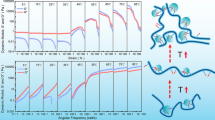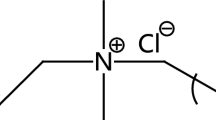Abstract
A novel class of hydrophobic associated copolymers with high content of nonionic surfmer was synthesized and characterized by 1H-NMR and GPC. These copolymers are the copolymerization product of 2-(acrylamido)-2-methylpropanesulfonic acid (AMPS) and different contents of nonionic surfmer AA-TX-100. The cac values of copolymer AMPS/AA-TX-100 series are increased with the decrease of surfmer units in the fluorescence test and concentration versus viscosity test, as the introduced surfmer units AA-TX-100 along polymer chain can lead to strong intermolecular hydrophobic association in water. Copolymer AMPS/AA-TX-100 series show better salt tolerance than poly-(2-(acrylamido)-2-methylpropanesulfonic acid) (PAMPS). The shearing resistance test shows that copolymer solutions have shear-thicken ability at low shear rate, which may be due to the susceptible intramolecular association formed by copolymers with high content hydrophobic groups (more than 1 mol%). Copolymers can reduce the interfacial tension between n-heptane/water, and the IFT values are around at 100 mN m−1 level and have good ability to form emulsions with good stability.








Similar content being viewed by others
References
Thomas S (2008) Enhanced Oil recovery—an overview. Oil Gas Sci Technol Rev IFP 63(1):9–19. doi:10.2516/ogst:2007060
James S (2011) Modern Chemical Enhanced Oil Recovery: Theory and Practice. Gulf Professional Publishers, Amsterdam
Green DW, Willhite GP (1998) Enhanced Oil recovery. Richardson taxis. Soc Pet Eng SPE Textbook Ser 6:1–7
Manrique EJ, Thomas CP, Ravikiran R et al (2010) SPE Improved Oil Recovery Symposium, Tulsa, Oklahoma, SPE 130113. doi:10.2118/130113-MS
Bondor PL, Hite JR, Avasthi SM (2005) SPE Latin American and Caribbean Petroleum Engineering Conference, Rio de Janeiro, Brazil. SPE 94637. doi:10.2118/94637-MS
Levitt DB, Pope GA (2008) SPE Improved Oil Recovery Symposium. SPE 113845. doi:10.2118/113845-MS
Seright RS, Seheult M, Talashek T (2009) Injectivity characteristics of EOR polymers. SPE Reserv Eval Eng 12(5):783–792. doi:10.2118/115142-PA
Pancharoen M, Thiele MR, Kovscek AR (2010) SPE Improved Oil Recovery Symposium. SPE 129910. doi:10.2118/129910-MS
Buchgraber M, Clemens T, Castanier LM (2009) SPE Annual Technology Conference. SPE (122400). doi:10.2118/122400-MS
Lewandowska K (2007) Comparative studies of rheological properties of polyacrylamide and partially hydrolyzed polyacrylamide solutions. J Appl Polym Sci 103:2235–2241. doi:10.1002/app.25247
Jime’nez-Regalado E, Selb J, Candau F (2000) Phase behavior and rheological properties of aqueous solutions containing mixtures of associating polymers. Macromolecules 33:8720. doi:10.1021/ma000579l
Zhou W, Zhang J, Feng G (2008) SPE Asia Pacific Oil and Gas Conference and Exhibition, Perth, Australia. SPE (115240). doi:10.2118/115240-MS
Stoll M, Al-Shureqi H, Finol J, Al-Harthy SA et al (2010) SPE EOR conference at oil and gas west Asia, muscat, oman. SPE 129164:226–240. doi:10.2118/129164-MS
Wang HY, Cao XL, Zhang JC, Zhang AM (2009) Development and application of dilute surfactant-polymer flooding system for Shengli oilfield. J Pet Sci Eng 65:45–50. doi:10.1016/j.petrol.2008.12.021
Feng YJ, Billon L, Grassl B et al (2002) Hydrophobically associating polyacrylamides and their partially hydrolyzed derivatives prepared by post modification. 1. Synthesis and characterization. Polymer 43:2055–2064. doi:10.1016/S0032-3861(01)00774-1
Gao B, Jiang L, Kong D (2007) Studies on rheological behaviour of hydrophobically associating polyacrylamide with strong positive salinity sensitivity. Colloid Polym Sci 285(8):839–846. doi:10.1007/s00396-006-1613-5
Bunio P, Chlebicki J (2012) New sorbic-type quaternary ammonium single-chain and gemini polymerizable surfactants: Synthesis, interfacial properties and anti-electrostatic activity. Colloids Surf A Physicochem Eng Asp 413:119–124. doi:10.1016/j.colsurfa.2012.03.060
Mahfud R, Agag T, Ishida H et al (2013) Synthesis and evaluation of novel anionic polymeric surfactants based on polybenzoxazines. J Colloid Interface Sci 407:339–347. doi:10.1016/j.jcis.2013.06.042
Herold M, Brunner H, Tovar G (2003) Polymer nanoparticles with activated-ester surface by using functional surfmers. Macromol Chem Phys 204(5):770–778. doi:10.1002/macp.200390049
Summers M, Eastoe J (2003) Applications of polymerizable surfactants. Adv Colloid Interf Sci 100–102:137–152. doi:10.1016/s0001-8686(02)00058-1
Takayuki H, Tsuyoshi S, Isao K (2000) Recovery and immobilization of metal sulfide nanoparticles from reverse micellar system onto thiol-modified polystyrene particles. J Phys Chem B 104(49):11639–11643. doi:10.1021/jp002290b
Wang FP, Du XZ, Wang C et al (2008) Synthesis and characterization of an amphiphilic graft copolymer with a poly (acrylic acid) backbone and n-octylphenyl polyoxyethylene side chains. J Appl Polym Sci 108:3677–3682. doi:10.1002/app.27239
Maiti S, Chatterji PR (2000) Aggregation and polymerization of amphiphilic macromonomers with a double bond at the hydrophilic termial. J Colloid Interface Sci 232:273–281. doi:10.1006/jcis.2000.7209
Zhong C, Wang W, Yang M (2012) Synthesis and solution properties of an associative polymer with excellent salt-thickening. J Appl Polym Sci 125(5):4049–4059. doi:10.1002/app.36743
Cui ZG, Cui CF, Zhu Y, Binks BP (2012) Multiple phase inversion of emulsions stabilized byin SituSurface activation of CaCO3Nanoparticles via adsorption of fatty acids. Langmuir 28(1):314–320. doi:10.1021/la204021v
Cui ZG, Yang LL, Cui YZ, Binks BP (2010) Effects of surfactant structure on the phase inversion of emulsions stabilized by mixtures of silica nanoparticles and cationic surfactant. Langmuir 26(7):4717–4724. doi:10.1021/la903589e
Song CL, An H, Zhang PP, Dewen Z, Pixin W (2011) Synthesis and solution behavior of hydrophobic association water-solublem copolymer containing anionic long-chain. Polym Mater Sci Eng 27(8):6–8, Chinese paper, article No.:1000-7555(2011)08-0005-04
Petit-Agnely FII, Zana R (2000) Hydrophobically modified sodium polyacrylates in aqueous solutions: association mechanism and characterization of the aggregates by fluorescence probing. Langmuir 16:9921–9927
An H, Lu C, Wang P et al (2011) A novel hydrophobically associating polyampholytes of poly (AM/AA/AMQC12): preparation, characterization, and solution properties. Polym Bull 67(1):141–158. doi:10.1007/s00289-011-0465-4
Rogalado EJ Selb J, Candau F (1999) Viscoelastic behavior of semidilute solutions of multisticker polymer chains. Macromolecules 32:8580–8588. doi:10.1021/ma990999e
Baskar G, Chandrasekar K, Reddy BSR (2004) Associated structures of aqueous solution of comblike polymers from 2-acrylamido-2-methyl-1-propanesulfonic acid, dodecylmethacrylate and poly (ethyleneglycol) acrylate macromonomer. Polymer 45(19):6507–6517. doi:10.1016/j.polymer.2004.07.037
Acknowledgments
This work was financially supported by major national Science and Technology program (2011ZX05024004). The authors thank the State Key Laboratory of Oil and Gas Reservoir Geology and Exploitation and the Engineering Research Center of Oilfield Chemistry, Ministry of Education Key Lab for experiment condition support.
Author information
Authors and Affiliations
Corresponding authors
Electronic supplementary material
Below is the link to the electronic supplementary material.
ESM 1
(DOCX 5266 kb)
Rights and permissions
About this article
Cite this article
Ye, Z., Zhang, X., Chen, H. et al. Synthesis and evaluation of a class of sulfonic water soluble polymer with high content of nonionic surfmer units. Colloid Polym Sci 293, 2321–2330 (2015). https://doi.org/10.1007/s00396-015-3609-5
Received:
Accepted:
Published:
Issue Date:
DOI: https://doi.org/10.1007/s00396-015-3609-5




